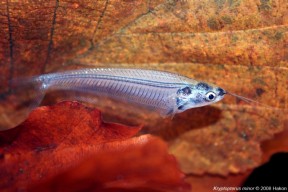Kryptopterus vitreolus
Glass Catfish
Etymology
Kryptopterus: from the Greek kryptos, meaning ‘hidden’, and pterýgio, meaning ‘fin’, in reference to the reduced or absent dorsal-fin in members of this genus.
vitreolus: from the diminutive form of the Latin adjective vitreus, meaning ‘of glass’, in reference to this species’ transparent appearance in life.
Classification
Order: Siluriformes Family: Siluridae
Distribution
Known only from a series of coastal river basins of Peninsular Thailand draining into the Gulf of Thailand south of the Isthmus of Kra, plus a handful of rivers draining the Cardamom (Khao Banthat) Mountains in southeastern Thailand.
Type locality is ‘Thailand: Trat Province, Amphoe Khao Saming’.
Ng and Kottelat (2013) state that its status in the wild requires investigation since it’s collected intensively for the aquarium trade, has a relatively restricted range and appears never to have been bred on a commercial basis.
Habitat
Displays a preference for slow-moving or standing habitats and has been collected from turbid brownish water as well as acidic blackwater.
Maximum Standard Length
55 – 65 mm.
Aquarium SizeTop ↑
An aquarium with base dimensions of 90 ∗ 30 cm or equivalent should be the smallest considered.
Maintenance
Best kept in a well-decorated set-up with some surface or floating vegetation since it appears to prefer relatively dim conditions.
The addition of dried leaf litter and/or alder cones would further emphasise the natural feel while the tannins and other chemicals released by these as they decompose are considered beneficial for fishes from blackwater environments.
Do not add this fish to a biologically immature aquarium as it can be susceptible to swings in water chemistry.
Water Conditions
Temperature: 20 – 26 °C
pH: 4.0 – 7.0
Hardness: 18 – 179 ppm
Diet
Probably a predator feeding on small invertebrates and zooplankton in nature.
In the aquarium it will accept dried foods of a suitable size but should also be offered daily meals of small live and frozen fare such as Artemia nauplii, Moina, grindal worm, etc.
Behaviour and CompatibilityTop ↑
Generally peaceful though it may predate on eggs or fry and is somewhat timid so does not compete well with much larger, robust or otherwise boisterous fishes.
Small, peaceful species make the best tankmates with examples from Thailand including Trigonostigma heteromorpha, T. espei, Brevibora dorsiocellata, Acanthocobitis zonalternans, Lepidocephalichthys, Acanthopsoides and Pangio spp.
Many species from other countries are of course also suitable but be sure to research your choices thoroughly prior to purchase.
K. vitreolus is highly gregarious and tends to form quite tight schools meaning a group of 6 or more specimens is the minimum recommended.
Sexual Dimorphism
Unknown.
Reproduction
Unrecorded.
NotesTop ↑
This species has been available in the trade for decades during which time it’s been widely misidentified as the congeners K. bicirrhis or, more recently, K. minor.
Its identity was not resolved until early 2013 at which point it was described as a new species by Ng and Kottelat, meaning you will see it under one of these two names in the majority of literature published prior to that date.
Unusually, the authors were required to publish a short communication just after the description since the words ‘new species’ did not feature in the first paper meaning that technically the name K. vitreolus remained unavailable as per Art. 16.1 of the ICZN code.
Alternative trade names include ‘Asian glass catfish’, ‘ghost catfish’ and ‘phantom catfish’, while it’s sometimes confused with the ‘African glass catfish’, Parailia pellucida.
Among other Kryptopterus spp. only K. minor and K. piperatus also possess a transparent body in life with the remaining species translucent or opaque, and these three are hypothesised to form a sub-clade within the K. bicirrhis species group (Ng & Kottelat, 2013; see below for definition of this species group).
K. vitreolus can be told apart from K. minor, K. piperatus and all other K. bicirrhis group members by the following combination of characters: snout length 29–35 % HL; eye diameter 28–34 % HL; body depth at anus 16–20 % SL; depth of caudal peduncle 4–7 % SL; maxillary barbels extending beyond base of first anal-fin ray; dorsal profile with pronounced nuchal concavity; 14–18 rakers on the first gill arch; 48–55 anal-fin rays.
Kryptopterus species are found only in Southeast Asia and the genus has been considered polyphyletic since Bornbusch (1995) with some former species already moved to the genera Phalacronotus and Micronema.
Those still contained within the genus are assigned to a number of putative species groups as follows:
K. bicirrhis group: K. bicirrhis, K. lais, K. palembangensis, K. macrocephalus, K. minor, K. piperatus, K. vitreolus
K. cryptopterus group: K. cryptopterus, K. geminus
K. limpok group: K. limpok, K. mononema, K. dissitus, K. baramensis, K. hesperius
K. schilbeides group: K. schilbeides, K. paraschilbeides
Bombusch (1995) identified the K. bicirrhis group as a distinct clade although he didn’t propose any synapomorphy to diagnose it.
Ng and Kottelat (2013) later noted that members normally have fewer anal-fin rays (46–67 vs. 64–85) than other congeners and placed K. piperatus and K. vitreolus within the group based on this character.
References
- Ng, H-H. and M. Kottelat, 2013 - Zootaxa 3630: 308-316
After eighty years of misidentification, a name for the glass catfish (Teleostei: Siluridae). - Bornbusch, A. H., 1995 - Zoological Journal of the Linnean Society 115: 1-46
Phylogenetic relationships within the Eurasian catfish family Siluridae (Pisces: Siluriformes), with comments on generic validities and biogeography. - Ng, H-H. and M. Kottelat, 2013 - Zootaxa 3640(2): 299-300
A name for the glass catfish (Teleostei: Siluridae) revisited.




